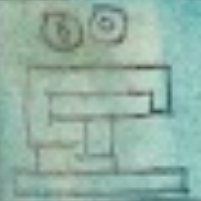Ome Calli (Mdz2r)
This simplex glyph plus notation stands for a solar year (xihuitl) date, Two House, also written 10-House. It has the notation (two ones, ome) on the top and the house or building (calli) below. The notation for the number one (just like many of the multiples) is a circle with a smaller concentrical circle. The standardly rectangular building with the T-shaped beams is a profile view, facing to the viewer's right. The entire date (including the background) is painted a turquoise (xihuitl) color, and it is enclosed in a black line-drawing box (not shown here).
Stephanie Wood
A boxed-in date says this refers to a year. The turquoise wash over the date is a visual reminder that these are dates, given that green and blue-green (xihuitl) is a homophone with the word for year (xihuitl). Thus, the paint could be a phonetic indicator for the word "year." Two House, 2-House, or Ome Calli, was a very important year in Aztec history. It was the year that the city of Tenochtitlan, which would become the imperial capital, was founded. This was 1325 C.E.
Stephanie Wood
c. 1541, or by 1553 at the latest
dates, fechas, ones, numbers, números, years, años, casas, edificios, arquitectura, houses, buildings, xiuhpohualli, turquesa, xihuitl

ome, two, https://nahuatl.wired-humanities.org/content/ome
calli, house or building, https://nahuatl.wired-humanities.org/content/calli
Codex Mendoza, folio 02 recto, https://digital.bodleian.ox.ac.uk/objects/2fea788e-2aa2-4f08-b6d9-648c00..., image 14 of 188.
The Bodleian Libraries, University of Oxford, hold the original manuscript, the MS. Arch. Selden. A. 1. This image is published here under the UK Creative Commons, “Attribution-NonCommercial-ShareAlike 3.0 License” (CC-BY-NC-SA 3.0).
